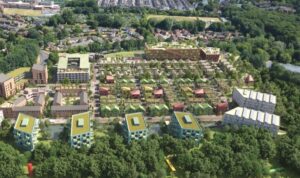Parc Hadau in south Wales, which will be one of the ‘world’s first’ net zero neighbourhoods, has been granted planning permission from Neath Port Talbot Council.
It will be the first scheme in the country to meet the UK Green Building Council’s definition of net-zero carbon, by tracking real-time ‘in-use’ carbon emissions when the homes are running.
The £8m development from Sero Homes will include 35 homes and they claim that residents will have no energy bills if they are within certain levels of usage.
The new homes will use a low energy building design to reduce the energy demands of the homes and their residents. This will be combined with a mix of renewable energy technologies, including thermal and electrical storage, significant on-site solar panels and ground source heat pumps, together with ventilation systems that keep the warmth inside whilst ensuring fresh, filtered air.
Intelligent controls by sister company Sero Energy will track carbon emissions from the National Grid to ensure any imported electricity’s emissions are more than balanced by those avoided from electricity generated on the site and exported from the homes.
The scheme is backed by more than £2m from the Welsh Government’s Innovative Housing Programme, which supports the innovative elements of the scheme. The remaining funding is provided through Sero Homes.
Richard Twinn, senior policy advisor at the UK Green Building Council, said: ‘Meaningful action over the next 10 years will be critical to help avoid the worst impacts of climate change. The energy used in homes accounts for around 20% of the UK’s emissions, so if we’re going to radically reduce emissions, we need all of our new homes to be net-zero carbon in operation by 2030 at the latest.
‘This represents a huge challenge for the industry. Housebuilders must act quickly to deliver homes that have very low energy demand and are powered entirely by renewable energy. Forward-thinking projects such as Sero’s Parc Hadau will help to lead the way so that we can turn net-zero into business as usual by 2030.’

















Leave a Reply